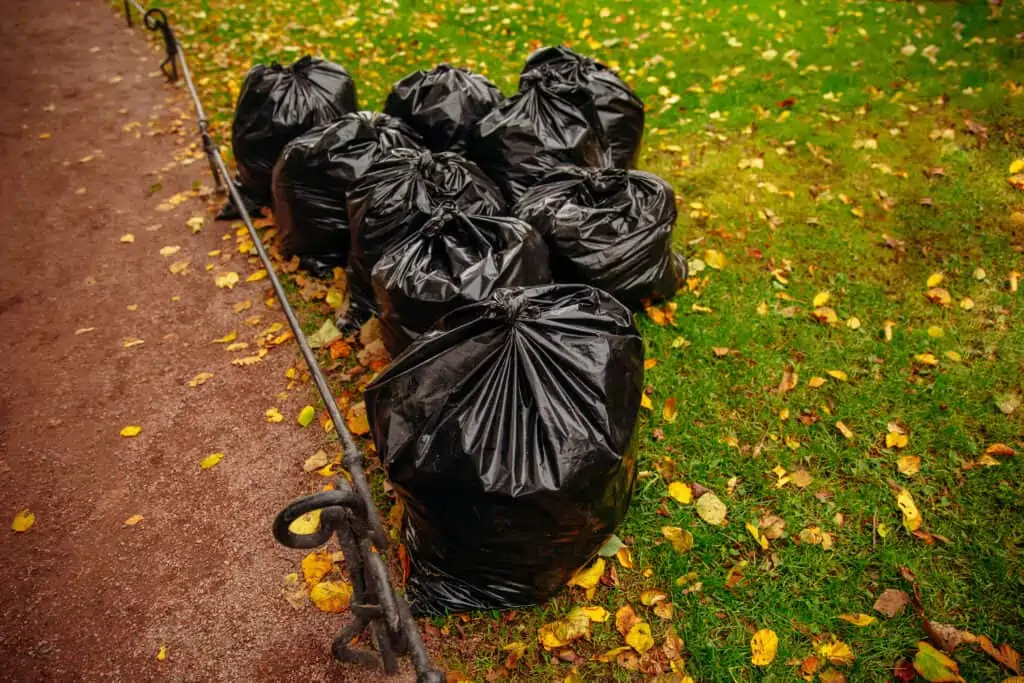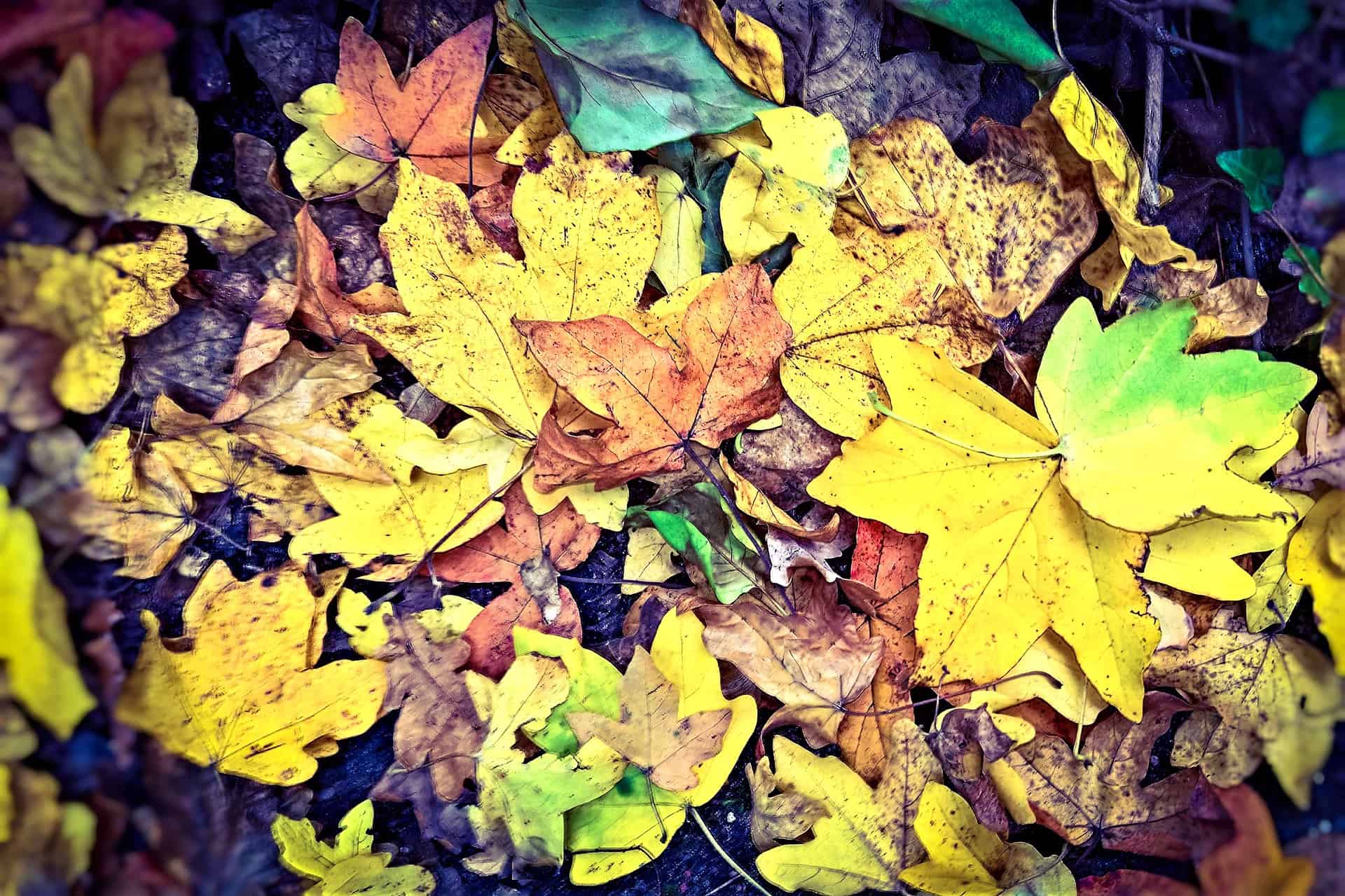As an Amazon Associate I earn from qualifying purchases.
Every fall trees such as Oak, Maple, Sycamores, and many others drop their leaves in preparation for the winter season. In nature, leaves provide important ecological services by protecting and nourishing the soils in which trees live.
In urban settings they often cause a nuisance, covering lawns, patios, driveways, and any surface you can think of. For smart gardeners, these leaves are not a nuisance at all but serve as an epic resource for making high-quality leaf mold compost.
However, composting large amounts of leaves comes with some challenges, especially if you’re trying to do it fast.
The Basics of Making Leaf Mold Compost
Using leaves to make leaf mold compost is one of the easiest and most effective methods for making high-quality compost effortlessly.
All it requires is a large number of fallen leaves, like those which become burdensome to many homeowners during the fall season.
Fallen leaves make a great resource because they generally have the proper balance of carbon to nitrogen (usually about 30:1) needed for making healthy compost.
4 Quick Steps For Making Leaf Mold Compost
1. Gather Your Leaves
You can gather your leaves with a rake or a leaf blower and start forming your piles. A wheelbarrow may aid in the movement of leaves in this step. If you don’t have all the leaves you need available, consider collecting them from other homeowners.
Some communities place their leaves in bags, boxes, or green bins for pickup on the curb during the fall season. Local laws may differ on the legality of collecting road-side “waste”, so check your local laws or consider asking the homeowner directly.
When collecting your leaves remember that not all leaves are created equal. Woody and tough leaves like those from Oak, Chestnut, Holly, and Beech will take longer to decompose because they are high in carbon.
In contrast, soft leaves like those from Alder, Maple, Ash, Sycamore, Fruit Trees, and Poplar will decompose quickly. If collecting leaf litter from evergreen species, consider that they also have woodier carbon-rich leaves.
2. Make A Pile
The next step is to pile your leaves in single or multiple piles. If your property is large and heavily littered with leaves you may choose to make different piles at strategic points on your land.
You will want your pile to be at least 4 feet square and 3 feet in height, but you can make the piles as large as needed. A pile 6 feet square and 5 feet tall is a good recommended size. One large pile will typically break down quicker than several small piles.
If you want to speed up the process you can shred the leaves with a lawnmower or weed whacker before you make the pile. Adding 1-2 cups of molasses per sqft of the pile will also help speed up the decomposition. To add molasses you can drizzle it evenly throughout the pile or dilute it in 1-2 gallons of water and spread it through your pile.
3. Monitor and Wait
Leaf mold compost takes about 6-12 months to finish composting depending on your climate and type of leaf pile. Within 1-2 weeks of making your pile, it should start producing heat and sometimes steam. Within a couple of months, you will start to see white mold-like growth consuming and breaking down the leaves.
Flipping your pile is not necessary like in other composting processes, but it does speed up the process.
The only real work that may be necessary is ensuring that your leaf pile has sufficient moisture for the decomposition process.
If your leaves become dry and crispy during spring/summer just give them a bit of water with a hose until they rehydrate. In excessively rainy climates you may choose to cover the pile or keep it in a roofed area, but again this is not necessary.

If you don’t have a large number of leaves to compost, you can make leaf mold compost faster by filling garbage bags with leaves, adding some moisture, and tying the bags off. The leaves will mold quickly and heat up much faster than if they were simply piled on the ground.
4. Use Your Leaf Mold Compost or Store it
A large unflipped pile of pure unshredded leaves should take about one year to break down. By shredding the leaves, feeding molasses, and routinely flipping the pile you can complete the compost in less than half the time.
You know your leaf mold compost is ready for use once it’s broken down into a beautiful dark, crumbly, homogenous structure. It should be soft and spongy with almost no recognizable leaf material.
At this point, it’s ready for use! It works great mixed directly into the soil or used as a top dressing in established beds or pots! Leaf mold compost is generally fungally dominated, making it a favorable amendment for perennial plants and trees. While it is not concentrated in macronutrients, it works great for providing water retention, air spaces, nutrient-holding capacity, and a food source to the soil food web.
If you don’t need it immediately you can easily store this material in bags, containers, or under a plastic tarp!
Other Considerations for Leaf Mold Compost
As with every other facet of composting, there are a few things to be aware of.
None of these will be deal-breaking but abiding by them will give you better results in a shorter amount of time.
- Avoid using pine, walnut, eucalyptus, and the leaves of conifers when composting. These will impede the decomposition process and may result in an overly acidic material.
- Composting in large plastic bags is also an option, just add the leaves, make 8-10 holes in the bag, and wait!
- Speed up the process by shredding the leaves, adding molasses, and flipping the pile routinely. If you notice your leaves are forming solid mats then flip the pile and break the mats apart to promote more air space. Spraying it with compost tea or other microorganisms will also help speed up the process.
- Fresh leaves from pruning remnants of downed trees will usually take longer to decompose. Any small sticks or branches mixed in with this material will also take longer to break down.
- Consider leaving leaves beneath valued trees as it helps protect the soil and keeps it healthy all while preventing the formation of mud. This is the composting method typically preferred by Mother Nature so, unless you find it unsightly or need the compost elsewhere, just let the leaves be and they’ll do it on their own!
3 Other Things To Do With Your Extra Leaves
1. Make Leaf Mulch
Using leaves as mulch is another excellent option if you find yourself with an excess amount of leaves. Do this by spreading generous layers of leaves beneath your trees and plants to deter weeds, hold moisture, and provide organic material.
Eventually, the leaves will break down into leaf mold naturally (slower than in a pile) and continue to nourish your soil. Shredding your leaves before may provide an easier material to spread in a garden, but consider that it will break down quicker.
2. Bulk Up Traditional Compost
Leaves can also provide excellent material for traditional composting. This means making a pile that incorporates manure, food scraps, or other nitrogen-rich materials.
When adding nitrogen-rich materials, consider using tough-woody (carbon-rich) leaves or adding something like sawdust or wood chips since leaves usually have the right balance of carbon to nitrogen. This is a good way to use tough-woody leaves that otherwise take a long time to decompose.
3. Mow Your Leaves
If your raking leaves off your lawn every fall, save yourself the effort and improve the health of your lawn by leaving them there and just mowing them! Just like leaving your grass clippings on the lawn, broken-down leaves will actually help the health of your lawn in the long run. Mowing them into small pieces will prevent them from harming the grass and speed up their decomposition.
In Conclusion
Like most composting endeavors, making leaf mold compost is as simple or as complicated as you want to make it. On the low-effort end of the spectrum, it is as simple as piling your leaves and waiting for them to break down.
If you need the process to speed up follow the recommendations mentioned above to cut the time in more than half. Once you become fluent in the world of leaf mold compost, you will understand the glorious abundance of supreme material naturally provided by nature every year.
You will no longer be cleaning leaves from your lawn or driveway but instead harvesting them for the production of high-quality compost!

